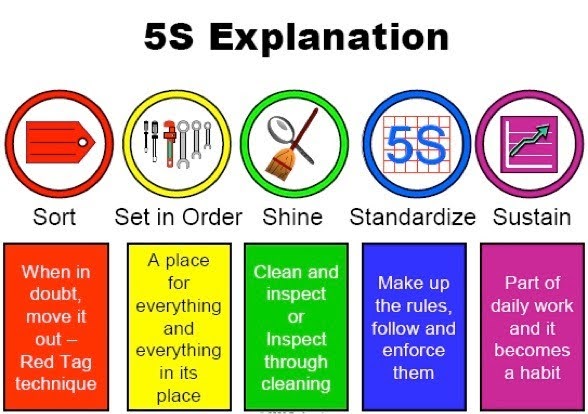
The goal of this article is to review the “WHY of 5S” along with the “TIME INVESTMENT of 5S”. A brief description of what 5S is given but the details of performing a 5S event are not. The details can be found in other locations at www.Nerd-Central.com.
Making the argument that 5S is the foundation to any solid Quality System is not a difficult leap. Most of what 5S entails is common sense. It’s all about Organization and Structure. Highly organized people would state confusion as to why others don’t naturally do 5S; why it’s not just a part of everyday life.
Besides being a highly effective productivity tool, 5S enhances safety and, overtime, it improves the culture of any organization. 5S engages people, ignites creativity and promotes self-discipline. 5S also reduces wasted time through workplace organization and improves workspace usage.
If your organization is void of a quality system, the 5S framework, roadmap and methods are a great place to start.
5S Defined
Let’s start by briefly explaining what 5S is. The acronym 5S is the reference to five key activities to achieving an organized, clean and visual environment. By vigorously and intentionally performing 5S activities, the benefits listed above can be achieved. In a nutshell 5S is simply the formalization of being organized.
As mentioned, 5S has five activities that allow for a structured roadmap. The five actions are:
- Sort – separating the needed from the unneeded. Sorting activities aim to eliminate unneeded items from the work area and to perform an initial cleaning.
- Straighten (or Set in Order) – a place for everything and everything in its place, clean and ready for use. Straighten arranges the workplace to ensure safety and efficiency.
- Shine – cleaning for inspection. Systematic daily cleaning and inspection of work areas and equipment help you understand current conditions and determine if corrective action is required.
- Standardize – The method by which “Sort”, “Straighten”, and “Shine” are made habitual, developing common methods for consistency. Standardizing aims to make abnormal conditions noticeable and to document agreements to ensure consistency and sustainability.
- Sustain – holding the gains and improving. Sustaining is aimed at maintaining the improvements from the other 5S activities and improving further.

As mentioned above, the aim is not to address the details of how to perform 5S activities but to address two questions:
- Why would you not follow this framework (or skip it altogether)? And
- Why would you not spend an enormous investment in time knowing that the outcome will support business excellence?
Following the Framework
So… why would you not follow a framework such as 5S? Especially since a high percentage of the world is not made up of highly organized and/or highly structured people”. Not a bad thing, we are all simply wired differently.
Having a clear, simple to follow framework in front of your employees allows them to have a repeatable workflow path that can be integrated into their DNA. Repeatable is the key word. By repeating the activity, the actions of performing 5S become habitual and this is the point at which the culture of the organization is elevated.
Some employees will take longer than others to consent to the process or will question the value and its benefits but with vigilance the transformation will happen.
Bottom line, most people need a framework to follow. With a defined framework, the methods become clear, making the desired results achievable.
Investing Time in 5S
I would like to suggest to any business that 5S is a great foundational tool and that by not spending a sufficient amount of time on performing 5S, the organization is losing out on not only the business efficiency’s but it’s also missing out on the cultural changes that need to happen to support an overall Quality System.
How long? The theoretical answer would be that you are always looking for 5S opportunities but I would say that an organization should spend at least 6 months to 2 years solely performing 5S activities.
The duration gap is due to the size of an organization. If you are a small 20 person custom manufacturing facility, it will take 6 to 9 months. If you are a part of a 1000 person assembly line facility, spend 1 to 2 years. Larger enterprises should break it down and have 5S trainers/facilitators to get the ball rolling. But no matter how large the organization, the message is the same; “Spend plenty of time with 5S only and reap the benefits”. Giving 5S its due before you dive into any other Quality framework, tool or program will build a stronger, longer lasting foundation so that obtaining business excellence is more easily achieved.
This timeframe is key. By intentionally spending an enormous amount of time performing 5S, the theoretical answer mentioned above will happen naturally and employees will start addressing 5S opportunities instinctively.
Conclusion
Although 5S will not solve all of today’s competitive challenges, it does provide a solid foundation for achieving operational excellence. In fact, some world-class companies claim that there can be no improvement without 5S.
The teamwork and discipline built through 5S improves worker-to-worker and worker-to-manager relationships. When people see that what they do makes a difference, and when they see that they have eliminated wasteful practices, their pride grows. This is perhaps the greatest benefit of 5S.




